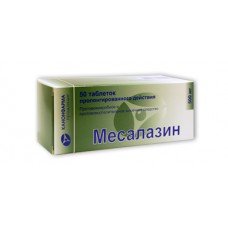Expiration date: 02/2026
International nonproprietary name: mesalazine
Dosage form: extended-release tablets
Composition:
1 tablet prolonged action contains:
the active substance mesalazine 500 mg
excipients: calcium hydrogen phosphate dihydrate, silica colloidal anhydrous (Aerosil A-300), copovidone (kollidon VA-64 or plasdone es-630), sodium alginate (Kelton LVCR), cellulose microcrystalline, magnesium stearate.
Description: tablets white or nearly white with serovatam brown color, round, lenticular shape. Slight inclusions.
Pharmacotherapeutic group: antimicrobial and anti-inflammatory gastrointestinal agent.
Pharmacodynamics
Has local anti-inflammatory effect due to inhibition of the activity of neutrophil lipoxygenase and the synthesis of prostaglandins and leukotrienes. Slows migration, degranulation, phagocytosis of neutrophils, and secretion of immunoglobulins by lymphocytes. Has antibacterial activity against Escherichia coli and some cocci (manifested in the large intestine).
Has an antioxidant effect (due to the ability to bind to free oxygen radicals and destroy them). Has good portability, reduces the risk of relapse in Crohn's disease, especially in patients with ileitis and long duration of the disease.
Pharmacokinetics
About 30-50% of the dose is absorbed mainly in the small intestine. Mesalazine undergoes acetylation in the intestinal mucosa, in the liver and, to a small degree, enterobacteria, forming N–acetyl–5-aminosalicylic acid. Connection with plasma proteins, 43%, and N–acetyl–5-aminosalicylic acid 73-83%. Mesalazine and its metabolite does not penetrate the blood brain barrier, penetrate into the breast milk.
Cumulative properties are available in healthy volunteers after administration of the drug at a dose of 1500 mg/day. Accumulates in chronic renal failure (CRF).
Mesalazine and its metabolites are excreted by the kidneys and intestines.
Indications for use
Ulcerative colitis, Crohn's disease (prevention and treatment of exacerbations).
Contraindications
Hypersensitivity, blood disease, ulcers disease stomach and duodenal ulcers, haemorrhagic diathesis, severe renal/hepatic insufficiency, during lactation, the last 2-4 weeks of pregnancy, children's age (till 12 years) and children with body weight less than 50 kg.
With caution
Pregnancy (I trimester), liver and/or kidney failure, the deficit glukozo–6-fosfatdegidrogenaza.
Use in pregnancy and lactation
It is known that mesalazine crosses the placental barrier, however, limited experience with the drug in pregnant women to evaluate the possible side effects. Use in pregnant women is possible only if the expected benefit to the mother outweighs the potential risk to the fetus.
Mesalazine is excreted in breast milk in concentrations lower than in maternal blood, whereas the metabolite acetyl-mesalazine is found in similar or higher concentrations. If necessary, use of the drug during lactation should decide the issue of termination of breastfeeding.
Method of application and doses
The mesalazine tablets of the prolonged action recommended to be taken whole without chewing, after eating, squeezed more liquid.
ULCERATIVE COLITIS
Acute stage
Adults: the dose is adjusted individually, usually up to 4 g mesalazine per day in divided doses.
Children: the dose is adjusted individually, usually 20-30mg mesalazine per 1 kg of body weight of the patient per day in divided doses.
Supportive therapy
Adults: the dose is adjusted individually, usually 2 g mesalazine per day in divided doses.
Children: the dose is adjusted individually, usually 20-30mg mesalazine per 1 kg of body weight of the patient per day in divided doses.
CROHN'S DISEASE
The stage of exacerbation and maintenance therapy
Adults: the dose is adjusted individually, usually up to 4 g mesalazine per day in divided doses.
Children: the dose is adjusted individually, usually 20-30mg mesalazine per 1 kg of body weight per day in divided doses.
Side effects
From the digestive system: nausea, vomiting, heartburn, diarrhea, loss of appetite, abdominal pain, increased activity "liver" transaminases, hepatitis, pancreatitis.
From the side of cardiovascular system: palpitations, tachycardia, increased or low blood pressure, chest pain, shortness of breath.
From the nervous system: headache, tinnitus, dizziness, polyneuropathy, tremor, depression.
From the urinary system: proteinuria, hematuria, oliguria, anuria, crystalluria, nephrotic syndrome.
Allergic reactions: skin rash, itching, dermatitis, bronchospasm.
On the part of the blood: anemia (hemolytic, megaloblastic, aplastic), leukopenia, agranulocytosis, thrombocytopenia, hypoprothrombinemia.
Other: weakness, mumps, photosensitivity, volchanochnopodobny syndrome, oligospermia, alopecia, reduction of slezna liquid.
Overdose
A single dose less than 150 mg/kg - overdose mild, 150-300 mg/kg - moderate, 300 mg/kg heavy.
Symptoms: mild and severe symptoms "of salicilizma" (nausea, vomiting, tinnitus, blurred vision, dizziness, severe headache, General malaise, fever is a bad prognostic sign in adults). Heavy - hyperventilation Central origin, respiratory alkalosis, metabolic acidosis, confusion, drowsiness, collapse, convulsions, anuria, bleeding. Initially, the Central hyperventilation leads to respiratory alkalosis shortness of breath, dyspnea, cyanosis, cold clammy sweat, with the strengthening of the intoxication is increasing paralysis of respiration and uncoupling of oxidative phosphorylation, causing respiratory acidosis.
In chronic overdose concentration determined in plasma are poorly correlated with the severity of intoxication. The greatest risk of chronic intoxication is noted in the elderly when taken in the course of a few days more than 100 mg/kg/day. In children and elderly patients early signs of salicylism not always visible, so it is advisable to periodically determine the concentration of salicylates in the blood: a level above 70 mg% indicates a moderate or severe poisoning above 100 mg% - on extremely severe, prognostically unfavorable. If poisoning moderate severity requires hospitalization for 24 hours
Treatment: the provocation of vomiting, the appointment of activated charcoal and laxatives, permanent control of acid-the basic composition of blood (KOS) and electrolyte balance, depending on the state of metabolism - the introduction of sodium bicarbonate, solution of sodium citrate or sodium lactate. Raising reserve alkalinity increases the excretion of mesalazine due to the alkalinity of urine. Alkalization of the urine is shown when the level of salicylates above 40 mg% and is secured by I/V infusion of sodium bicarbonate (88 mEq in 1 l 5% dextrose solution, at a speed of 10-15 ml/h/kg), restoration of volume of circulating blood (BCC) and the induction of diuresis is achieved by the introduction of sodium bicarbonate in the same dose and dilution, repeat 2-3 times. Use caution in elderly patients in whom intensive fluid infusion can cause pulmonary edema. Not recommended the use of acetazolamide for alkalinization of urine (can cause acidemia and enhance the toxic effect of salicylates). Hemodialysis is shown at the level of salicylates more than 100-130 mg%, in patients with chronic poisoning - 40 mg% and below if there are indications (refractory acidosis, progressive deterioration, severe CNS, pulmonary edema and renal failure). In oteke light - artificial lung ventilation (ALV) mixture enriched with oxygen.
Interaction
Enhances hypoglycemic effect of sulfonylureas, the ulzerogennosti glucocorticoids, methotrexate toxicity. It weakens the activity of furosemide, spironolactone, sulfonamides, rifampicin. Enhances the action of anticoagulants. Increases the effectiveness of uricosuric drugs (blockers kanalzeva secreta). Slows the absorption of cyanocobalamin.
Special instructions
Appropriate regular holding of General blood analysis (before, during, and after treatment) and urine, control of excretory function of the kidneys.
Patients who are "slow acetylators" have an increased risk of side effects. There may be urine staining and tears in the yellow-orange color, the painting of soft contact lenses.
In the case of pass receiving medication missed dose should be taken at any time or together with the next dose.
If you skipped several doses, continuing treatment, consult a doctor. If you suspect the development of acute intolerance syndrome mesalazine should be abolished.
Patients should avoid driving and performing activities that require high concentration and psychomotor speed reactions.
Release form
Extended-release tablets, 500 mg. of 10 or 15 tablets in a contour cell package made of polyvinylchloride film and aluminum foil printed patent.
1, 3, 5, 6, 9, or 10 contour cell packs of 10 tablets or 2, 4 or 6 contour cell packs of 15 tablets, along with instructions for use is placed in cardboard pack.
Shelf life
3 years.
Do not use after expiration date.
Storage conditions
List B. In dry protected from light place at temperature not exceeding 25°C.
Keep out of reach of children.
Conditions of supply of pharmacies
According to the recipe.


